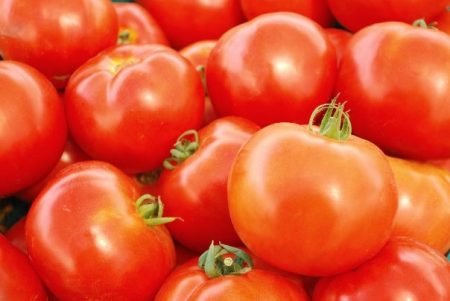 Tomato "Grandmother's Gift" - one of the most famous hybrid varieties of the last decade. Thanks to the crossing of maternal varieties, which were resistant to many adverse external factors and diseases, this hybrid has become a leader among first-generation tomatoes. He possesses strong endurance, unpretentiousness in leaving and gives at the same time plentiful harvests.
Tomato "Grandmother's Gift" - one of the most famous hybrid varieties of the last decade. Thanks to the crossing of maternal varieties, which were resistant to many adverse external factors and diseases, this hybrid has become a leader among first-generation tomatoes. He possesses strong endurance, unpretentiousness in leaving and gives at the same time plentiful harvests.
Content
Grade characteristics
The hybrid variety “Grandma’s Gift” was bred by domestic breeders from the “Protected Ground Vegetable Research Institute”. In 2010, the variety was listed in the State Register for the Russian Federation. Designed for cultivation in open ground in the southern regions and under film shelters - in the middle latitude.
"Grandmother's gift" refers to a group of varieties with medium-late ripening. The first tomatoes enter the stage of technical ripeness 120 days after germination. Before full maturity, they will need another 7-10 days.
The plants are indeterminate, vigorous, grow in a greenhouse up to two meters. Be sure to require garters and the formation of two to three stems. Stamp do not form. The leaves are large, dark green, slightly wrinkled, rarely located. The root system is highly developed, located near the surface.
Since the bushes have unlimited growth, a month before the full harvest, the top should be pinched, directing the forces of the plant to ripen the fruits.
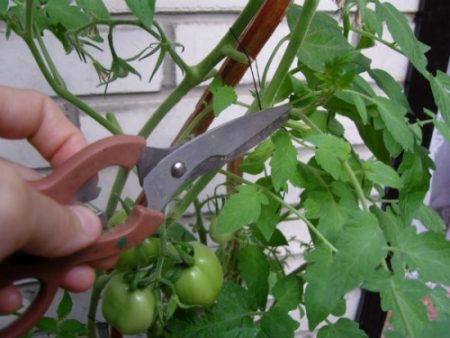
The first brush is formed over 6-7 sheets, then through two sheets. On each brush, 7-8 medium-sized tomatoes are formed.
The fruits themselves are characterized by a regular round shape, slightly flattened at the shoulders, slightly ribbed. Weight reaches 250-270 grams. The skin is thin, but elastic, not prone to cracking. When fully ripened, it has a bright red color. The number of chambers is 8. There are a lot of pulp. It is distinguished by its juicy, sweet taste with a slight acidity and a pleasant fresh aroma.
Grade Advantages:
- high productivity;
- endurance;
- large-fruited;
- fruits of an apparently attractive shape;
- good taste;
- friendly fruiting;
- fruits are formed until mid-autumn;
- high resistance to diseases.
Minuses:
- the fruits are not stored for long;
- long growing season;
- constant garter, stepsoning is required;
- in open ground does not give such good results.
Due to this characteristic, tomatoes of the Grandmother's Gift variety are ideal not only for fresh consumption, but also for various types of preservation. During heat treatment, their taste and shape remain at the level.
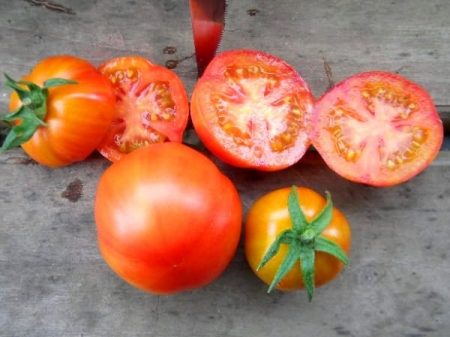
High productivity of hybrid bushes is noted. Subject to the rules of agricultural technology, one bush forms up to 6 kilograms of selected tomatoes.
Growing Features
When assigning dates for sowing seeds for seedlings, consider that the hybrid is late-ripening. Therefore, sowing can be done already at the end of February in order to get the crop on time.
Land for seedlings is prepared from humus, garden soil and peat. It is disinfected by spilling boiling water or calcining in the oven. Mineral elements are added to the soil and moisturize well.
Seeds are also treated with manganese solution to kill all possible pathogens. After the procedure, the material must be thoroughly washed and dried. Before sowing, seeds are soaked in a growth stimulator to provide more massive germination.
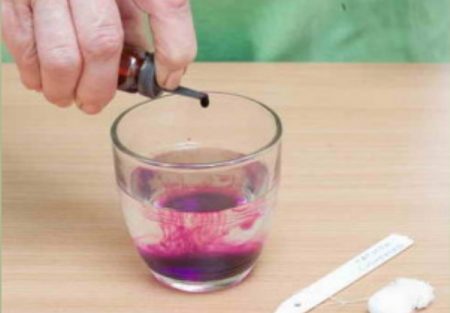
Seeds are sown in long grooves at a distance of 2-3 centimeters from each other. Deepening is carried out to a depth of 0.5-1 centimeter. Sprinkle with dry soil on top of the planting and again carefully water it.
Growing seedlings
Seedling boxes must receive a lot of sunlight so that plants produce the optimal amount of chlorophyll. Since in early spring the daylight hours are short, it is necessary to install artificial lighting.
To shoots appeared faster, planting covered with a film. Inside, a greenhouse effect is created - favorable for seedling. As soon as the seeds germinate, the film is removed.
The temperature in the room should not be lower than 25 degrees. This can be achieved by exposing seedlings near the battery. But it is not worth putting seedlings too close with a heat source, since the air there is too dry.
Seedlings are regularly watered by sprinkling. The earth should not be too wet - this will cause the development of the fungus. It is necessary that the soil always remains semi-dry.
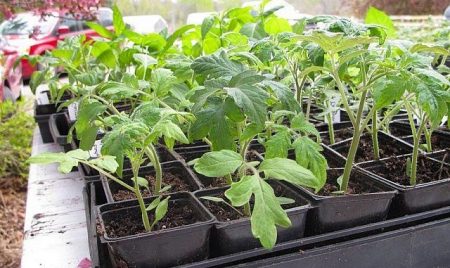
As soon as the first leaves appear on the sprouts, seedlings are dived. Seedlings are planted in separate (at least half a liter in volume) containers.
A couple of weeks before planting in the garden, seedlings are hardened. Prepared seedlings will more resistant to stress during transplantation to a new place. At the time of planting, 7-8 leaves will appear on each seedling and at least one flower brush will form.
Landing
With planting seedlings do not rush. After all, planting bushes in the ground does not mean getting an earlier crop. On the contrary, in a hurry, you can lose the lion's share of seedlings, since the soil may not warm up enough, and there is also a risk of night frost returning, which the seedlings simply will not survive.
The best time to land is the end of May. You can drop into the greenhouse two weeks earlier.
Grandma’s gift is a variety that is especially unpretentious to external factors, however, it is demanding on the composition of the soil. Tomatoes grow well in slightly acidic soil (the optimum pH should be between 6.0 and 6.8.). If the acidity of the earth on the site is low, then when digging into the soil, lime is added. If on the contrary, above, then sulfate is added. Tomatoes feel good in the ground, where there is a lot of sand or clay. The main thing is also to supply the land with abundant nutrients. Composting will help. The more manure, the better.
Seedlings are planted in separate pits, pre-harvested. At the bottom lay some compost, ash, superphosphate. The soil before this is well moistened. Tall tomatoes are placed at a considerable distance from each other, so that subsequently the giants do not obscure each other. The minimum distance between the bushes is 45-50 centimeters. Between the rows leave 90-100 centimeters. The holes are closed with a depth of 15-20 centimeters, so that the entire earthen lump with roots fits in it, and 3-4 more centimeters remain above them. From above, the bushes are covered with earth and slightly compacted so that the planting does not fall apart.
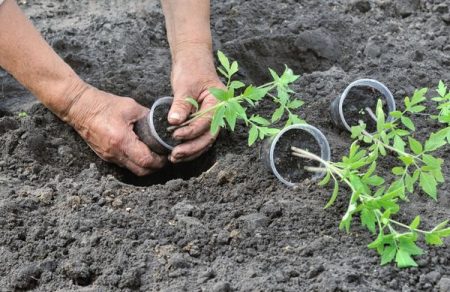
Care
Tomatoes Grandma's gift is unpretentious in leaving. They are distinguished by good endurance before the vagaries of nature. Bushes can be in heat and drought for a long time. However, in order to grow a decent and high-quality crop, you should not let everything go by its own accord and pay maximum attention to tomato beds.
Fertilizers
Such a giant variety like Grandma’s kiss requires frequent fertilization, as well-developed roots should nourish a two-meter stalk, with a large green crown, a dozen brushes and a large number of fruits. From how fertilizing will be regularly applied, how much the plant grows powerful and how many fruits it will form depends on.
However, you should not think that in matters with top dressing you need a lot of effort and cost. Many summer residents successfully apply the simplest dressing for vegetable beds.
Initially, the planted seedlings should be strengthened and build up a strong and thick above-ground part. To violently overgrow leaves and stems, plants need nitrogen. This substance is full in ordinary manure or compost. Therefore, during the closing of the beds in the ground, a large amount of humus or old manure is added, which will feed the young seedlings. 2 weeks after planting, the bushes are again fed with a good portion of organics, consisting of mullein or bird droppings. Of course, one organics will not help in the formation of a plentiful crop.
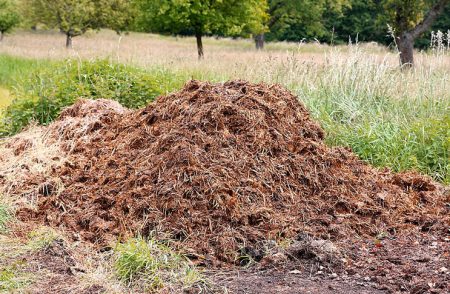
For top dressing, complex mineral fertilizers are also used, which nourish plants with all the necessary vitamin and trace elements that contribute to the proper development of plants. Therefore, during planting, ash and superphosphate are added to the hole.
During flowering and fruiting, plants no longer need nitrogen. The turn comes for potassium and phosphorus. These elements contribute to the formation of delicious and beautiful fruits. Therefore, the number of these elements should be increased. Before fruiting, you need to fertilize the bushes with nitrate.
Tomatoes respond well to foliar fertilizing when plants are sprayed, and not fertilized under the root. Through the leaf, nutrients travel much faster.
Watering
Tomatoes "Grandma's kiss" are heat-resistant. They can survive even the driest summers without losing a single fruit. The bushes are unpretentious to watering, they can calmly survive the absence of another watering. But you should not get involved in irregular irrigation of plantings, as this can affect the quality of the fruit. If the plants receive a small amount of water during the growing season and ripening of tomatoes or irrigation is uneven, the taste of the tomato becomes unbalanced, and the fruits themselves will be smaller in size.
Pouring a planting is also detrimental to a tomato, as well as a lack of water. Excessive moisture will lead to the development of fungus and rot.
Water for irrigation tomato needs to be used only warm, from a barrel. Spring water can delay the development of the plant, as its low temperature damages the roots of the bush that nourish the entire plant.
Tall tomatoes should be watered under the root, without touching the aerial part of the bush. So the leaves and stems will remain dry, which means that pathogenic microflora will not develop on them. During flowering and intensive fruit ripening, bushes especially need water that will fill the fruits. Therefore, during these periods the number of irrigations can be increased. On hot days, it is worth watering tomato beds every other day. And in a temperate climate, it is enough to carry out this procedure twice a week. Each bush requires up to 3-4 liters of water daily.
To keep moisture in the ground longer, the surface under the bushes can be mulched. A covering layer of sawdust or grass will protect the water from rapid evaporation. In addition, the mulch, decaying, will nourish the roots of tomatoes with its useful trace elements.
Garter
Perhaps this is the most troublesome occupation in growing tall varieties of tomatoes. Tie bushes should be immediately after planting on the bed. Plants can be tied up locally, that is, by placing a peg on each bush and, as it grows, produce a garter. But this method can harm the roots, since the stakes need to be driven deep into the ground, and there is a risk of running into the rhizome.
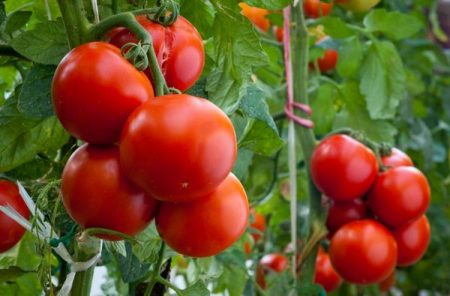
Better use a trellis. Strong stakes are installed from different ends of the beds, between which a layer of thread is stretched. The first layer should be 30 centimeters above the ground. When the bushes grow, pull a new layer. Garter stems and fruiting branches of tomato bushes are carried out to this thread.
Creating optimal conditions for the full growth of tomato bushes
Tomatoes grow well in sunny, calm areas. In the shade, the bushes are very elongated and poorly knit. In addition, a lack of light leads to weakening of plants, falling flowers. Therefore, many summer residents in the rainy and cloudy summers in the greenhouses install artificial lighting.
Although tomatoes like water, humidity should be lowered. With constant heat and high humidity, the flowers are poorly pollinated, the risk of developing various diseases develops, which leads to a decrease in yield. Therefore, it is important to set the air humidity in the greenhouse within 75-80%.
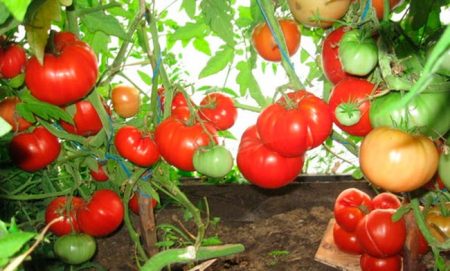
For a full life, plants need oxygen. In the open ground, plants get it naturally. It is worth taking care of the constant influx of fresh air into the greenhouse. Plants get carbon dioxide, oxygen and nitrogen from it.
In order for the optimum amount of oxygen and moisture to get into the soil, it is necessary to process it: to loosen, weed.
Disease
The “Grandmother's Gift” hybrid has a high susceptibility to diseases such as the tobacco mosaic virus, black leg, fruit cracking, bacteriosis, and alternariosis. But quite often it is affected by such an unpleasant and incurable disease as late blight. It is believed that this is one of the most common diseases among vegetables, which develops in a humid and excessively warm environment. Spores that are in the soil or seedlings in such a "greenhouse" climate germinate, multiply rapidly and contribute to the defeat of all parts of the tomato plant, including the fruits themselves.
Identified affected plants must be immediately removed from the garden, otherwise late blight will spread to all healthy plantings. Fruits from diseased plants can not be eaten.
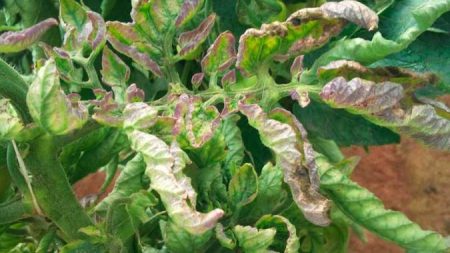
But phytophthora is better to fight by the method of prevention, preventing its development. So that the plants do not get sick with such a dangerous disease, it is necessary to carry out stepsoning regularly, not to thicken the plantings. This is all done so that the bushes are well ventilated, and excess moisture does not accumulate on the beds. Watering should also be timely. The greenhouse must be regularly ventilated and the plants must be provided with plenty of sunlight.
Reviews
Linda
Growing a variety of "Grandmother's Gift F1" in the greenhouse. She led bushes in one trunk. By the way, I’m leading all tall in one trunk, because caring for them is facilitated at times, and yield is still good. Grandma's gift plants are very strong, powerful. The trunk is well overgrown with foliage and beautiful tassels. Knits well. Even in the heat there were a lot of ovaries. The fruits are beautiful, round in shape. Ideal for whole-fruit preservation. But the taste did not impress me, very mediocre for me. The ripening of fruits in the variety is uneven, fruiting is extended. 5-7 fruits are formed in the brush. The bushes are very tall, they waved me under two meters. In general, the variety is not bad.
Victoria
Just a wonderful variety with such a kind and sweet name Grandma’s gift. I have been growing it for several years, I have already learned all the nuances associated with the cultivation of these tomatoes. In our North, of course, it is better to grow tomatoes in a greenhouse. I plant seedlings on the garden in the last days of May. Bushes begin to bear fruit by the end of July. Feeding is very fond of. Plants are tall, 180 centimeters tall. I use trellis for garter. There are not very many fruits on the bush. Each brush carries up to 8 tomatoes. The size and weight of the tomatoes are all aligned. It tastes juicy, fleshy, sweetish. But, frankly, in all hybrids the taste is not as pronounced as in varietal tomatoes. But, taking into account all the positive aspects of this variety, then "Grandmother's Gift" is an excellent option for growing. The bushes almost never get sick, they knit well, they give a lot of beautiful fruits that can be eaten fresh, and let them go to various salts.
Helena
Good standard grade. Especially not stand out. As befits hydrides, tomatoes steadily endure the vagaries of the weather, the trunks of the bushes are strong, they hold well. They grow two meters tall. But I don’t even pinch the top, it does not bother anyone. Harvest manages to fully ripen before the onset of cold weather. The taste is good, but there are tomatoes and sweeter.




 Low-growing tomatoes, without pinching: 5 of the most delicious varieties
Low-growing tomatoes, without pinching: 5 of the most delicious varieties Why tomato seedlings grow poorly
Why tomato seedlings grow poorly We grow a tomato in a shell
We grow a tomato in a shell Growing tomatoes without watering according to the method of Kazarin
Growing tomatoes without watering according to the method of Kazarin